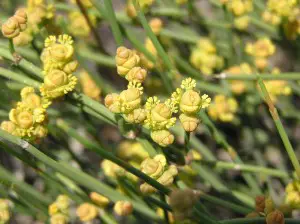
Flowering plants are scientifically known as angiosperms, and their seeds are encased in fruit or flowers. Gymnosperms are naked seeds that do not have fruit around them, such as pinecones. Gnetophytes could be the common ancestor between flowering plants and gymnosperms, of gnetophytes could be gymnosperm evolving into a kind of flowering plant. Scientists don’t know, and as they seek to find out, they have these facts to go on.
Fact 1: There are 3 extant gnetophyte genera, or three groups of gnetophytes that still exist today. Ephedra and Welwitschia are desert plants, and Gnetum survives in tropical, moist habitats. Â There is only one species of the Welwitschia genera, which lives in the Namib Desert. In contrast, Ephedra has a global distribution of its 30 species. Gnetum has less than 36 species, most of which are woody climbers, but two of which are trees.
Fact 2: Like flowering plants, gnetophytes have vessels in the xylem and sieve tubes in the phloem, which are used to transport food and water inside the plant. Angiosperms have both ovules and pollen in the same flower, and gnetophytes may make a similar structure, though it is often not what is traditionally thought of as a flower.
Fact 3: Gnetophytes are similar to gymnosperms in that they make cone like conifers. The difference is that the gnetophytes have ovules and pollen sacs on the end of the secondary shoots instead of on the stem. Gymnosperm compound ovules or pollen into cones, but gnetophytes put both into their cones.
Fact 4: Like woody plants, it is expect that gnetophytes were much more divers and populous in the past, before the rise of flowering plants. Fossils dated to the Early Cretaceous period show the earliest gnetophyte, living with early angiosperms. Fossilized pollen that resembles the pollen of the modern Ephedra dates back to the Triassic and Cretaceous ages.
Fact 5: Ongoing arguments over classification of gnetophyte have not been helped by molecular phylogenetic analysis. Genetically, the gnetophytes are closer to gymnosperms, though they are physically more similar to angiosperms.
Fact 6: Some botanists thought a new group should be formed, chlamydospermae, or enveloped seed. This group would show that the gnetophytes were a mix of both angiosperms and gymnosperms.
Fact 7: The development of a female gametophyte in Welwitschia is unique, not replicated in either gymnosperms or angiosperms. The female parts of reproduction, or the egg, has several nuclei, which migrate into the middle of the ovule. Male pollen is introduced, a fertilization bulb is formed, and the embryo grows downward in the upright tubes. This allows for the development of fused bracteoles, which makes the see look like it has a single wing attached.
Fact 8: Welwitschia develops two large leaves that grow throughout the life of the plant. They split and fray with age, making it look as if there are more leaves.
Fact 9: Gnetum vines or forms trees, and the seeds are likely to be brightly colored. The leaves will be large and flat, with reticulated veins, or veins that branch off multiple times.
Fact 10: Ephedra have small leaves with 2 or 3 veins, and the mature cones may become brightly colored and look filled out.










Leave a Reply